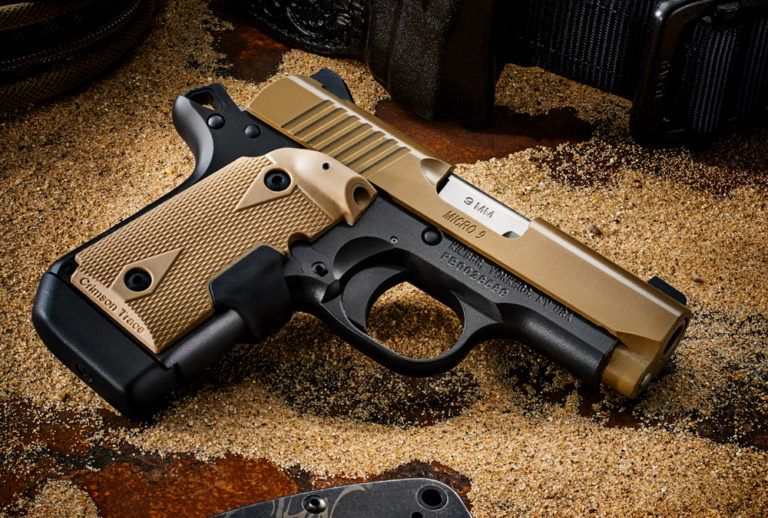
Both Kimber Micro 9 and SIG P938 are slim and potent concealed carry pieces, but which one comes out on top?
Commonground between the Kimber Micro 9 and SIG P938:
- Both use a 1911-style platform.
- Each has barrels at or near 3-inches.
- They utilize single-stack magazines.
- The pistols have full-sized sights.
- Each has 1911 controls.
- Both have sarrated triggers.
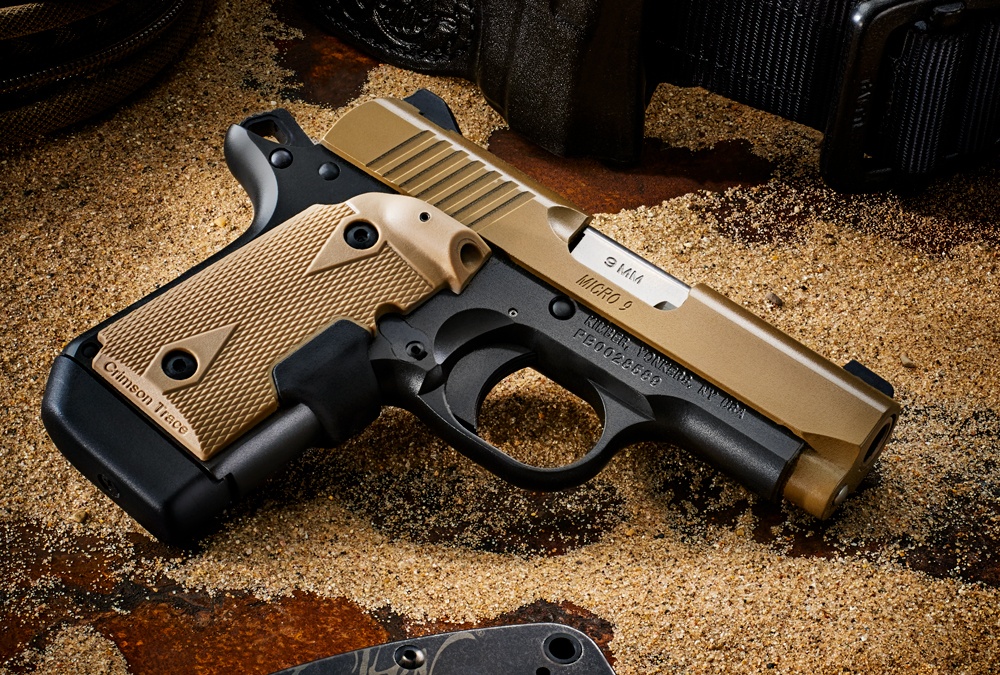
Although both the SIG Emporer Scorpion P938 and Kimber Micro 9 use a 1911-style platform, what separates these two micro shooters is aesthetics, controls and ergonomics. The Kimber Micro 9 Desert Tan (LG) with laser grip and the SIG Emperor Scorpion P938 are both micro 9mm pistols with barrels that measure 3- and 3.3-inches, respectively, and have a single-stack magazine — clearly designed for concealed carry.
These micro 1911s look similar to the full size, but the systems are quite different.
Raise Your Sig Sauer IQ
Scaled down for concealment, the Kimber and SIG are packed with 1911 design elements. Those include the controls, single-action trigger, and grip angle, all adding up to make a truly backup-sized 1911. If you are familiar with the 1911 then the transition to one of the micro 1911s will be seamless.

The thumb safety, slide release and magazine release are just like those in the 1911 design. These mini 9mms disassemble with ease so maintenance is not a chore.
For speed testing, I performed the Bill Drill at 7 yards, firing a magazine as fast as I could while keeping hits in an 8-inch circle. The intent of this drill is to improve speed without eroding accuracy.
It also was an opportunity to run the pistols dry, check for slide lock-back, perform numerous magazine changes, and repeatedly use the slide release as well as test rapid sight alignment and trigger press. I started at the low-ready position. Here’s what I found running these micros muzzle to muzzle.
The Kimber Micro 9 Desert Tan (LG) looks like a shrunken Government 1911 model with its rounded slide top and internal extractor. The fit and finish are well executed and held up during testing. The model was equipped with Crimson Trace laser grips, which in my opinion enhances the shootability of the tiny handgun at close range.
The pistol came in a soft case with two magazines, each of which had an extended rubber bumper floorplate that act as a finger rest. The floorplate is rounded on all edges. In fact, the edges of the Micro 9 are rounded making it snag-free for a smooth draw from deep concealment.
I liked the large 3-dot sights. Speaking of sights, those found on both the Kimber and SIG are similar in size to ones used on full-sized guns, which made shooting easier.
The Kimber has a left-side thumb safety like the setup on a Government 1911A1. It’s easy for a right-handed shooter to manipulate the safety with the thumb of their shooting hand, though the SIG provides a bit more safety lever surface area and was slightly easier to manipulate.
A button on the front strap activates the laser grips. Simply grasping the pistol activates the laser. I could also loosen my grip and turn it off. I liked the ease of activation and use. A switch on the left grip allowed me to completely turn off the laser.
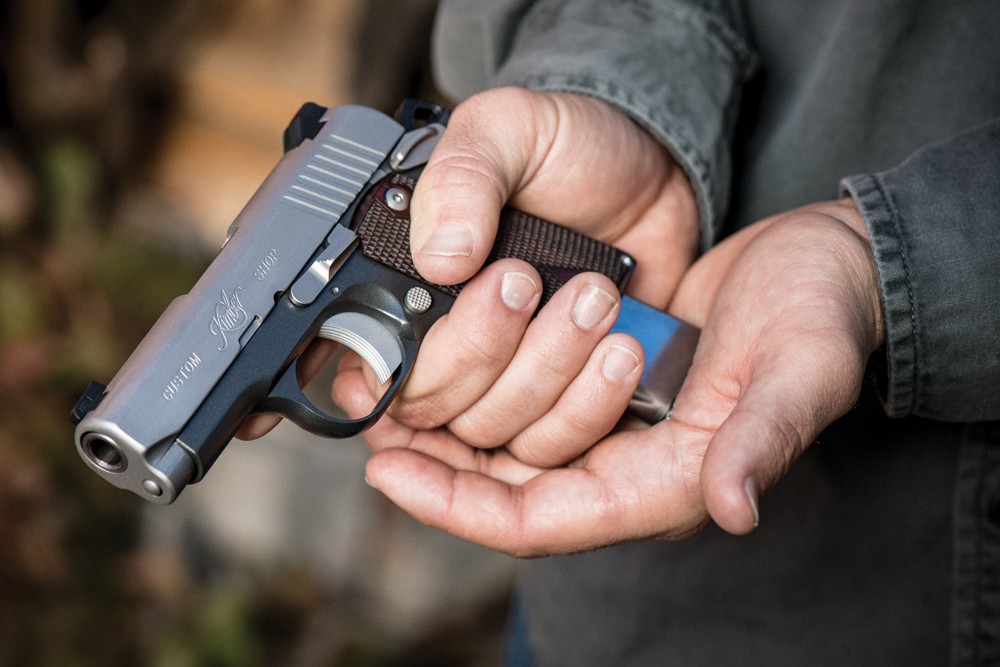
The grips themselves have textured polymer and felt thicker in my hands compared to the SIG. The SIG felt thin and flat. Its mag release button was simple to work and dumped the stainless magazines freely.
The Micro 9 has slightly more hammer surface area for texture than the SIG, so it is a bit easier to cock, though neither were difficult. The Micro 9 has a slightly larger beavertail than the SIG so ham-fisted testers feel more comfortable shooting the Kimber.
The trigger is serrated so your trigger finger pad or first knuckle stick to it better during recoil. There is a polymer insert in the rear strap with fine checkering that helps keep a grip on the gun when shooting. Field stripping is easier than a Government 1911 and is the same for both pistols.
In hand, I liked both guns but be aware these lightweight 9mms can produce recoil. That said, the recoil from either was controllable, even pleasant. The Kimber slide required 14 pounds of force to rack and cock, slightly less than the SIG.
Twenty-five yards is pushing the range of these small pistols but, due to the single-action trigger, large sights, and a rest, I was able to shoot five-shot groups that averaged 4 inches. My best group was with Aguila 124-grain FMJ ammo — a 3.2-inch group. In close range, I was able to shoot them fast and accurately.
SPECIFICATIONS
MODEL: Kimber, Micro 9 Desert Tan (LG)
CALIBER: 9mm
ACTION: Short Recoil, Locked Breech
TRIGGER: Single Action
BARREL LENGTH: 3.15 in.
OVERALL LENGTH: 6.1 in.
WEIGHT: 15.6 oz. (unloaded)
GRIPS: Checkered Polymer Crimson Trace Laser Grips
SIGHTS: 3-Dot, Laser Pointer
FINISH: Desert Tan/Matte Black
CAPACITY: 6+1, Single-Stack Magazine
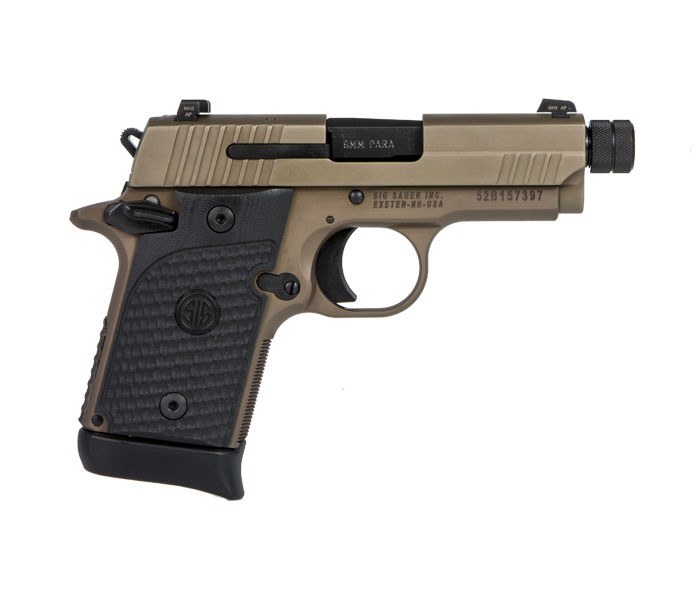
SIG Sauer P938 Emperor Scorpion
The SIG Sauer P938 Emperor Scorpion is striking in appearance with an FDE (flat dark earth) finish and G10 grips. It comes in a hard case with two stainless-steel magazines; one with a finger rest and one without, the latter of which fits flush in the butt. In the case was a SIG polymer OWB (outside-the-waistband) holster.
I used the magazine with the floorplate finger rest for most of the testing since I liked this setup the best. The finish was well executed on the SIG — no surprise there. I expected the SIG to run and it did. But first, let’s get into what makes the SIG different from the Kimber.
The slide of the little SIG is shaped like those found on SIG’s other models. That is, blockier and squared off. Sights are large, allowing you to be in charge. This model features Siglite 3-dot night sights. It took about 15 pounds of effort to rack the slide and cock it.
I liked the fact the SIG had serrations at the muzzle and rear of the slide. (The Kimber had serrations only at the rear.) I appreciated being able to rack the slide using a variety of methods. I also found the larger sights allowed me to rack the slide on the edge of a Kydex holster, tabletop, and nearly any edge. The outside edges of the SIG are sharper and less smooth than the Kimber.
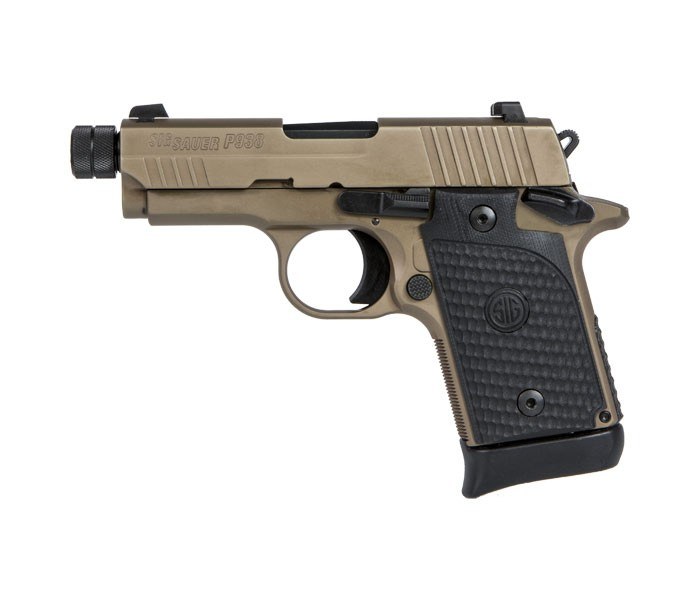
The SIG features an external extractor and an ambidextrous thumb safety that is slightly easier to manipulate than the Kimber. There is a bit more metal to allow me to flick it on and off without drastically changing my grip.
The serrated hammer has a bit less surface area to grasp and cock than the Kimber. The beavertail is smaller than the Kimber’s, but I did not experience hammer bite. The face of the trigger is serrated, useful when shooting for speed.
The SIG is much flatter and thinner. The rest found on the floorplate is handy — it makes the pistol feel like a larger piece. What set these micro nines apart from other striker-fire or DAO 9mm pistols is their relatively large sights. The SIG is a small pistol, but it feels like a large one and is easier to shoot.
Using a rest and shooting out to 25 yards, the SIG was a pleasure to shoot due to its grip, sights and crisp single-action trigger.
I was able to put five rounds into a 3.1-inch group with Armscor 124-grain FMJ ammunition. On average, the handgun grouped 3.5 inches. In terms of accuracy, I would say the SIG and Kimber were comparable. For the speed shooting phase of testing, I favored the toothy texture of the SIG as it stayed adhered to my hand with no discomfort. The front grip strap is checkered, and it has a plastic checkered insert in the rear strap — lots of texture without being raspy to the hand. The Kimber laser grips are slicker to the grasp.
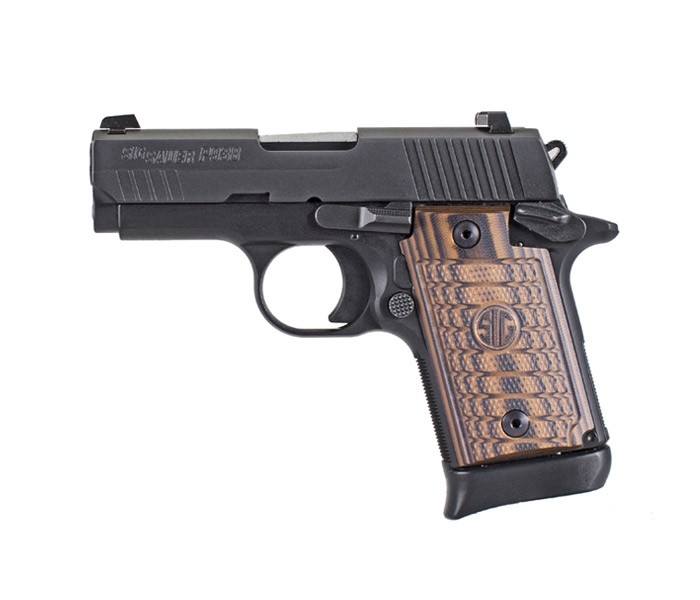
Both pistols performed flawlessly. At close range, the Kimber Micro 9mm is accurate and easy to handle. The laser allows faster aiming in dark conditions while the full-size sights make aiming easier. I like all the smoothed edges and the beavertail.
The SIG feels thinner and has a better texture than the Kimber. The SIG has large night sights that served me well. Recoil is pleasant but more noticeable with these lightweight micro nines.
SPECIFICATIONS
MODEL: SIG Sauer P938 Emperor Scorpion
CALIBER: 9mm
ACTION: Short Recoil, Locked Breech
TRIGGER: Single Action
BARREL LENGTH: 3.0 in.
OVERALL LENGTH: 6.0 in.
WEIGHT: 16.0 oz. (unloaded)
GRIPS: Piranha G10 with Medallion
SIGHTS: 3-Dot, Siglite Night Sights
FINISH: FDE
CAPACITY: 6+1, Single-Stack Magazine
Editor’s Note: This excerpt is from 9mm: Guide to America’s Most Popular Caliber, available now at GunDigestStore.com.
Raise Your Sig Sauer IQ:
- Sig Sauer Pistols
- P225-A1
- P320
- P516
- MCX
- P220
- P320C
- 516 Patrol Rifle
- P250
- P6
- M17 Civilian Variant
- P365
- P226
- P290RS
- MCX Rattler

Next Step: Get your FREE Printable Target Pack
Enhance your shooting precision with our 62 MOA Targets, perfect for rifles and handguns. Crafted in collaboration with Storm Tactical for accuracy and versatility.
Subscribe to the Gun Digest email newsletter and get your downloadable target pack sent straight to your inbox. Stay updated with the latest firearms info in the industry.

![Best Concealed Carry Guns In 2025 [Field Tested] Wilson Combat EDC X9S 1](https://gundigest.com/wp-content/uploads/Wilson-Combat-EDC-X9S-1-324x160.jpg)


![Best 9mm Carbine: Affordable PCCs [Tested] Ruger Carbine Shooting](https://gundigest.com/wp-content/uploads/Ruger-Carbine-Shooting-100x70.jpg)
![Best AR-15: Top Options Available Today [Field Tested] Harrington and Richardson PSA XM177E2 feature](https://gundigest.com/wp-content/uploads/Harrington-and-Richardson-PSA-XM177E2-feature-100x70.jpg)

“Both have sarrated triggers.” Really? “Sarrated”? You should fire your spell checker. Still, good article and I like the Kimber better but then I am kind of a Kimber fan boy.